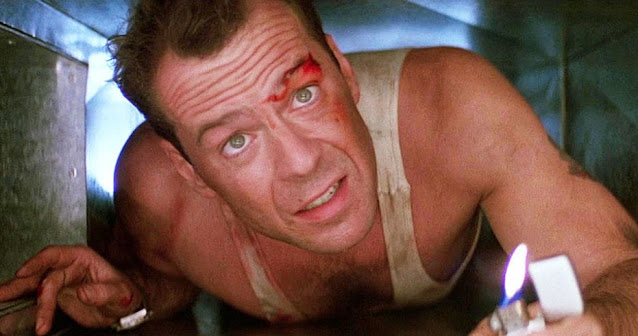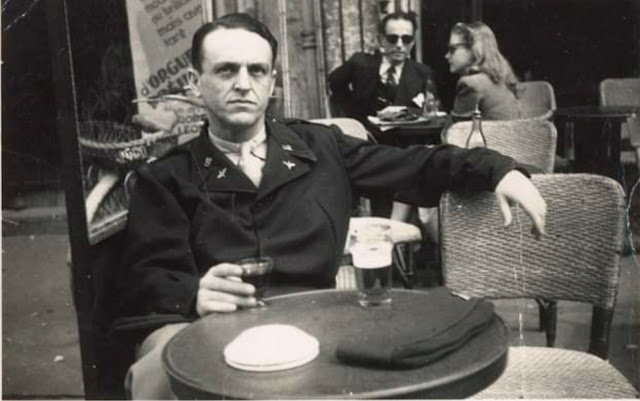The Writing of "Blazing Saddles": Five Heads Are Better Than One
In 1971, Andrew Bergman was a 26-year-old aspiring academic whose biggest accomplishment so far had been having his doctoral dissertation, titled We’re in the Money: Depression America and Its Films, published by New York University Press. Unable to land a university teaching job, Bergman had spent the previous year working as a trade-press flack for United Artists. During that time, “inspired by a vision of H. Rap Brown on horseback in the prairie,” Bergman wrote a screenplay titled Tex X – which was destined eventually to become Blazing Saddles.
 |
| Voting rights activist H. Rap Brown, Andrew Bergman's original inspiration for his screenplay "Tex X," which became Blazing Saddles |
The source of Bergman’s inspiration – H. Rap Brown – was a voting rights activist who was named chairman of the Student Nonviolent Coordinating Committee in 1967, the same year he was arrested in Cambridge, Maryland after a fiery speech he gave there resulted in a riot. From an early age, friends had called Brown ‘Rap’ for his ability to express himself eloquently with a hip street sensibility. Brown is most famous for a line in a speech he gave in Detroit in 1967, “Violence is as American as cherry pie.” In that speech, he continued, “This country has delivered an ultimatum to black people. America says to blacks, ‘You either fight to live, or you will live to die.’ I say to America, ‘Freedom or death.’” Brown went on to become a Black Panther Party leader and militant provocateur, calling upon fellow civil rights advocates to “meet violence with violence.” As the movement progressed, Brown became a focal point for a federal crackdown on radical Black Power advocates, and by the time Blazing Saddles was made, he was serving five years in Attica Prison.
Writer Andrew Bergman recalled, “I wrote a script – first draft – in 1970, 71. That’s where it began. And Warner Bros., lo and behold, bought it, much to my amazement. And they hired Alan Arkin to direct and James Earl Jones to play the black sheriff. And for some reason, that fell apart.”
At the time, director Mel Brooks was looking for work. His last film, The Twelve Chairs, had fizzled at the box office. “For me, it all started with me walking the streets of New York looking in the gutter, hoping to find some change,” he said. “I was looking for my next project. I was around 59th Street near 5th and I heard a voice say, ‘Mel, Mel,’ then louder, ‘Mel.’ It was the late great David Begelman, who had just created an agency… ’Come with me,’ says David, and buys me lunch, takes me into his office, spends five hours with me – and he’s the busiest man. ‘We’ve got to get you a job – you’re too talented,’ he said. ‘I’m going to be your agent without commission until you’re on our feet, and then if you want to hire me, fine.’ He turns me from a wistful cultist failure into a critically assailed commercial success, in a period of 18 months. I will be forever grateful to him.”
The second person who played a fateful role in Brooks’ resurrection was Judy Feiffer, a Warner Bros. story editor. Feiffer had liked The Producers and The Twelve Chairs and was in the habit of sending scripts in Brooks’ direction on the off chance he might want to direct one. Brooks recalled, “I didn’t want to do a studio picture, I wanted to do what I wanted to do. But I was fast running out of money when she sent over the best of the lot, a rough script written by Andrew Bergman.”
When David Begelman handed him the Tex X script, Brooks initially demurred. “I read it and I said, ‘You know, I don’t do things that I don’t write. But this is very funny.’ So David said, ‘Write it.’ I said, ‘Well, it’s already written.’ ‘No, no this is just a skeletal outline. It’s a profile of what it can be. It needs bones and flesh,’ David said. So I said, ‘Let me take it home.’ I took it home. I let my wife, Anne Bancroft, read it. She loved the idea. I said, ‘Tex X, that’s a cute title, I like that title. Tex X. Malcolm X, Tex X, a black guy.’”
“What grabbed me were the possibilities of a modern black man arriving in the traditional West,” Brooks said. “Like, he’d say, ‘Right on, baby!’ and they’d say, ‘Consarnit!’ Then I realized that at the same time, I could make fun of Westerns and the West.”
When Mel Brooks signed on to direct, he insisted that “the guy who came up with this wildness” be made part of the team. Brooks said, “Usually you throw out the original writer, you always just get him off the set, you get rid of him, because he’s trouble, he’s a lot of trouble. But I liked Bergman. His concept was very basic – 1974 in 1874. I said, ‘OK, great. We can do that.’”
“I sat down with the Warners people and proposed an arrangement – let me have Bergman and three other writers, give me some seed money, and we’ll write it the way we used to do Your Show of Shows,” said Brooks. “And they said, ‘Why do you want the original writer, when we have his script?’ I said, ‘I’m sure there’s more in his head, since we liked his idea so much.’ They agreed. So I called Bergman and said, ‘Do you mind if I despoil your script?’ And he said, ‘Can I help?’”
Andrew Bergman recalled, “I wrote a story about a hip, black, modern sheriff dropped into the old West. Warners bought it and got Mel Brooks to direct, and he wanted to do a flat-out satire of the West. I had a choice of saying, ‘You will not touch my material,’ or saying, ‘OK.’ I was 26 at the time, and it was great experience.”
When Brooks met Bergman, whom he described as “a nice Jewish boy, quiet and smart,” he figured Bergman would balance the other writers’ madness. “But it turned out that Andrew Bergman was crazier than anybody,” Brooks said. Bergman said Brooks taught him that screenwriting requires a knack for collaboration and compromise, though Brooks described his method as “getting a group of crazy people together and going berserk.”
Brooks also wanted to have an authentic black voice on his writing team. He tried to hire Dick Gregory, the outspoken political satirist and stand-up comedian, but failed to interest Gregory in the project. So Brooks decided to call Richard Pryor. “Richie was then just a stand-up comic working in a couple clubs, and wasn’t that well-known,” Brooks said. “But I was a big fan. I knew how bright he was.”
Pryor recalled, “Mel Brooks called and asked if I was interested in working with him on a script for a Western. Mel and I had never met, but I knew of his brilliant reputation, starting with Sid Caesar. I was excited just to talk to him. After the script arrived, I read it quickly, and Mel and I talked again. ‘So this is a comedy?’ I asked. ‘Yes,’ he said. I said, ‘Then why don’t you make it one?’”
At the same time, Brooks recalled an encounter he’d recently had with an aspiring screenwriter. “A guy came up to me and was raving about The Producers, and I said, ‘What do you do?’ He said, ‘I’m a young lawyer and I want to be a young screenwriter and I want to give up being a lawyer. I’m working with a dentist.’ I said, ‘On your teeth or on a script or what?’ He said, ‘No the guy’s a comedy writer and we’re a team.’ So I’m talking about Norman Steinberg, who went on to write My Favorite Year with me. And then his writing partner was a guy by the name of Alan Uger. I told Andy about the dentist and Norman, and I said, ‘I have a feeling that these guys are good.’”
“So we called in Norman Steinberg and Alan Uger, a Jewish comedy team, and Richard Pryor, a black person of outré imagination,” Brooks said. “Then we turned on the tape recorder and started bullshitting. Pryor wrote the Jewish jokes, the Jews wrote the black jokes. Nine months later, we had a finished script.”
According to Andrew Bergman, “The writing process was insane when there were five of us writing, which was for about 8 weeks of the first draft.” Brooks remembered that “everybody was fighting to make the best joke. There was a secretary in with us on every session, going crazy trying to take everything down. We didn't use a tape recorder, because it inhibits writers. They start editing and playing to the recorder… We went all the way – especially Richard Pryor, who was very brave and very far-out and very catalytic.”
Brooks was careful to set some guidelines for the writing. “When you satirize, you have to be careful to know what the clichés are, and use them… Blazing Saddles isn’t a ‘black’ movie, but more of a juxtaposition of hypocrisy, greed, flat-out fun and clichés that I’ve been watching since I was three years old. The point is, we’re trying to use every Western cliché in the book – in the hope that we’ll kill them off in the process.”
For Andrew Bergman, the experience went beyond anything he could have ever imagined. “Sitting in a room with Mel and Richard was like a Marx Brothers movie… Mel was coming off two pictures, neither of which had done any business, and Richie Pryor was sort of on the outs at the time, so we were all sort of coming off the same starting line in one fashion. It was amazing. To me, the movie was even funnier in that room than it was on the screen. I remember Richie Pryor disappeared once and came back dressed as a cleaning lady and started dusting. That was the funniest room anyone will ever be in.”
 |
| Only a meeting of the minds of Mel Brooks and Richard Pryor could have resulted in the dark, zany genius of Blazing Saddles |
Brooks said, “Five of us got together and came up with a rough draft of 412 pages, enough for a movie of seven to eight hours. Warners then funded another go at it. This time, we got it to 275 pages, or approximately twice the length of a shooting script. When they told us to proceed to shooting script, I decided I wanted to shoot it. Badly. I loved it. I said to Warners management, ‘You’re crazy to do this, but if you want to, it’s on your own head.’”
“To me, the whole thing was like a big psychoanalytic session,” Mel Brooks admitted. “It just got everything out of me – all of my furor, my frenzy, my insanity, my love of life and hatred of death.”
Sources:
“No Tex X,” Publisher’s Weekly, 7/10/72
A. H. Weiler, “Mel Brooks Goes West,” New York Times, 11/26/72
Hollis Alpert, “Comedy: The New King,” Saturday Review/World, 11/2/74
Brad Darrach, “Mel Brooks,” Playboy, 2/75
Jacoba Atlas, “Mel Brooks Interview,” Film Comment, 3/75
Philip Fleishman, “Interview with Mel Brooks,” McLean’s, 4/17/78
William Wolf, “No Laughing Matter,” New York, 5/18/81
Eric Pooley, “The Unknown King of Comedy,” New York, 5/27/85
Sean O’Neill, “It Happened to Him,” Village Voice, 8/5/94
Blazing Saddles DVD: “Back In the Saddle” Featurette
Blazing Saddles DVD: Director Commentary
Mara Shalhoup, “As American as Cherry Pie,” Creative Loafing, 1/23/02
James Robert Parish, It’s Good To Be the King, 2007


Comments